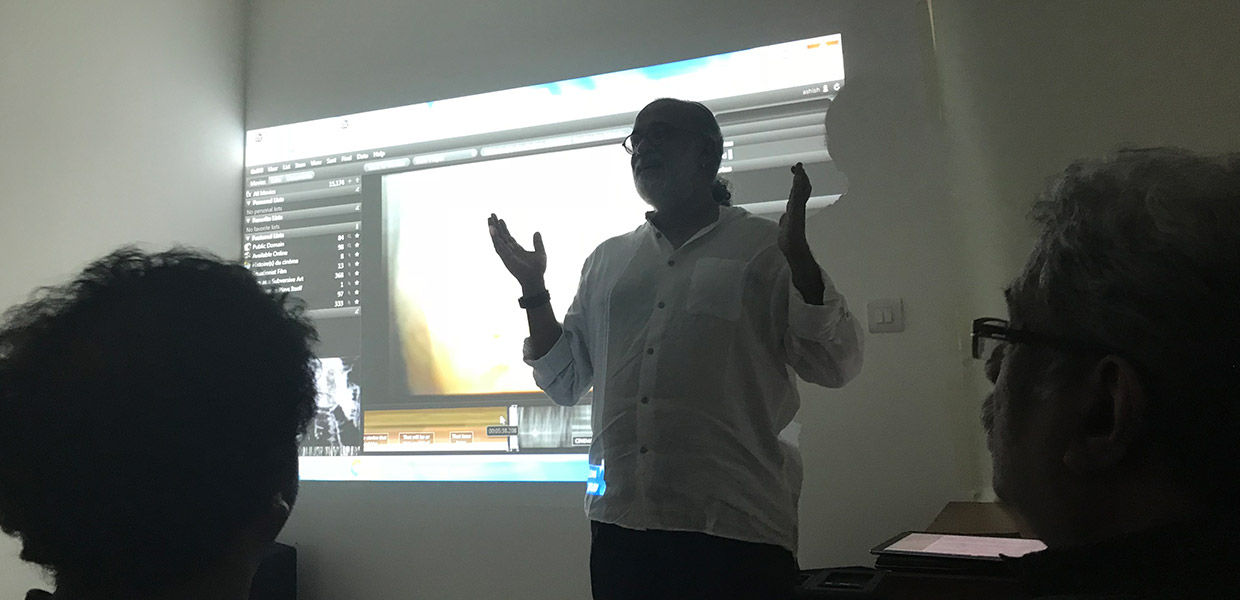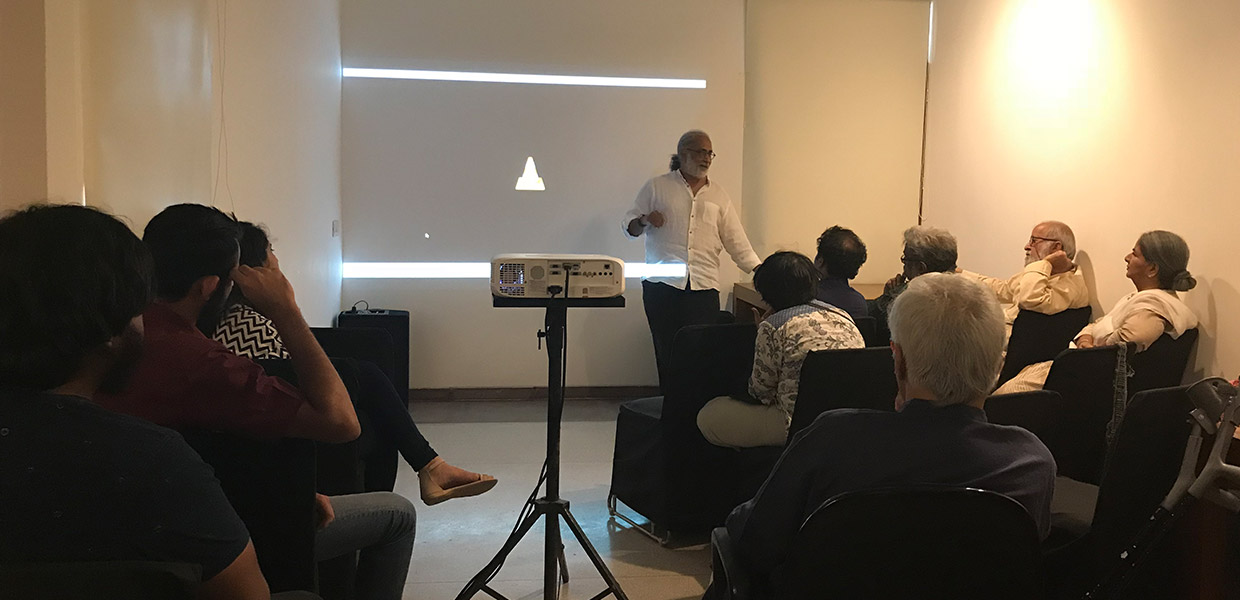A Three-Part Screening and Discussion Programme Conducted By Ashish Rajadhyaksha
21 April 2018 | New Delhi
For some decades now, all research into radical traditions of art making has also been a battle against the ravages of time. Art, we know, is brittle: it either does not survive, or when it does, bears the scars of history. It is a given, in our situation, that historical research has to at once include the ability to unearth new and unusual sources, as well as display the ability to imaginatively reconstruct from surviving fragments what may have happened. In the case of art, this may be a case of retrospectively fabricating what an ‘original’ work may have been like from extant copies, from secondary sources and from speculative reconstructions.
A new and unexpected twist has taken place, as the restoration economy, moving via architecture and visual art to film, has begun creating clean and unblemished versions of old classics. In 2013, Ritwik Ghatak’s legendary Titash Ekti Nadir Naam was reissued in digitally remastered and restored form by Martin Scorcese’s ‘World Cinema Project’. This was one of a box-set of six films released to fulfil the project’s mission to ‘preserve and present marginalized and infrequently screened films from regions generally ill-equipped to preserve their own cinema history. Titash had been filmed in 1973, soon after the Bangladesh war, unfinished at the time of Ghatak’s death, and was, given that only one print was believed to exist in Dhaka, effectively considered lost. In the mid-1980s, however, a sprawling and unwieldy three-plus hour epic version of the film surfaced in the European film festival circuit. Since then, it has been in various ways ‘cleaned up’ under the aegis of the Ritwik Memorial Trust so that now, made with state-of-the-art technology, we have what will undoubtedly become the Titash everyone knows henceforth.
In 2017, another famous film resurfaced. Jago Hua Savera (1957) was conceived when it was made, as a co-production across what was then West and East Pakistan, and India. Directed by Pakistan’s A.J. Kardar who was assisted by one of Bangladesh’s most enigmatic documentary filmmakers, Zahir Raihan, partially based on Manik Bandopadhyay’s Padma Nadir Majhi, adapted into an original screenplay by Faiz Ahmed Faiz, featuring India’s Tripti Mitra alongside a host of major Bangladeshi actors, with music by Timir Baran and cinematography by the British-Greek cinematographer Walter Lassally (The Loneliness of the Long-Distance Runner, Zorba the Greek), this subcontinental collaboration has been a historical conundrum. Baul music is sung in Urdu, as performative styles clash and a cinematographic idiom derived from British Free Cinema shows framed images in top-angle and extreme deep focus. Seeing it today, and perhaps working against the grain of the restoration, may well need us to view it as an assemblage of fragments to be discursively reconstructed by viewers now doing another kind of not-unfamiliar historical labour: another act of radical restoration.
The problem itself is not new: incomplete masterpieces, and films posthumously and controversially ‘completed’ are well known (Eisenstein’s Que Viva Mexico! being the classic instance). Here, however, in speaking of the problem as specifically to do with socialist film histories, I propose a rather different route for approaching it. Through the 1980s Jean-Luc Godard was deeply bothered by a situation that seems to bear similarity to what we face here. In an extended series of film collages he titled Historie(s) du Cinéma, Godard put hundreds of film fragments together ranging from clips of major Hollywood productions to independent videos, over a free-associative commentary. These texts have baffled (and irritated) viewers, and have led to a small academic industry trying to make what meaning they can of a style that appears to have been designed to be, at once, unarchivable, un-copyrightable and incomprehensible.
If we derive from our situation, of putting films back in our Lab for fragmentation and reintegration, a way to seeing Godard’s own assemblages less as text and more as method, new possibilities emerge that return us to a historical method we had once used, and might need to use again. Godard describes such a method, at one point, in Film-Socialisme (2010), as the need to ‘shield’ images from ‘language’: something that he says can paradoxically be achieved only when we ‘actually make use of them because they are in the desert, and that’s where one has to look for them’.
And so, if our own effort to ‘put to use the images we receive from our Left legacy, if we fragment and reconstruct filmic material in a way that might bear some resemblance to Godard’s injunction that our ‘use’ will also ‘shield them from language’ (such language now including the language of restoration), we may have forged a new way to make sense of the films before us. We may also have better success with understanding an old European master who continues to have something to say to our collective engagement with film.
— Ashish Rajadhyaksha
Grateful acknowledgment: CAMP, Sebastian Lutgert
PROGRAMME
11 am: An Introduction and a Provocation: Ashish Rajadhyaksha
11.30 am – 1 pm: Jago Hua Savera (1957, digitally remastered version 2017, 92 minutes)
Director: A.J. Kardar. Original story: Manik Bandyopadhyay. Screenplay and Dialogues: Faiz Ahmed Faiz. Music: Timir Baran. Cinematography: Walter Lassally. Cast: Zurain Rakshi, Khan Ataur Rehman, Tripti Mitra. Produced by: Noman Taseer for Century Films (Karachi)/Films De Light (London)
1 pm -2.30 pm: Lunch
2.30 pm – 5.10 pm: Titash Ekti Nadir Naam (1973, digitally remastered version 2013, 156 minutes)
Director/Screenplay/co-music: Ritwik Ghatak. Original story: Advaita Malla Burman. Co-music: Bahadur Khan. Cinematography: Baby Islam. Cast: Golem Mustafa, Kabori Sarwar, Rowshan Jamil, Prabir Mitra, Rosy Samad, Rani Sarkar, Fakhrul Hasan Bairagi, Farid Ali
Produced by: Habibur Rehman Khan
5.30 pm – 7.15 pm: Film-Socialisme (2010, 102 minutes)
Director: Jean-Luc Godard. Cinematography: Fabrice Aragno, Paul Grivas. Cast: Catherine Tanvier (well known tennis player), Christian Sinniger, Jean-Marc Stehle, Nadege Beauson-Diagne, Patti Smith (singer), Alain Badiou (philosopher).
7.15 pm – Discussion
Ashish Rajadhyaksha is an independent scholar, author of Indian Cinema in the Time of Celluloid: From Bollywood to the Emergency (2009), The Last Cultural Mile: An Inquiry into Technology and Governance in India(2011) and other books.




